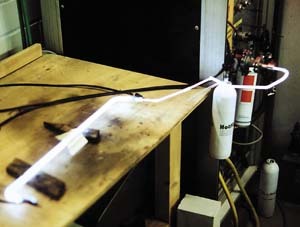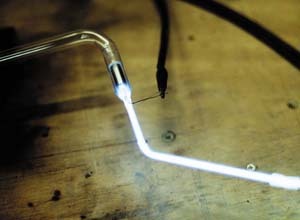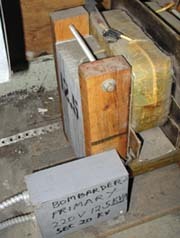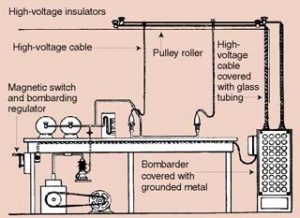"I can’t remember anything" may be the first words spoken by a pumper who awakes (if he’s lucky) after having experienced a severe flashback in the manifold. In a neon-pumping system, a "flashback" refers to an electrical discharge that enters the vacuum system during bombarding (Fig. 1) — a situation that’s dangerous and, in some cases, lethal for the operator. This month, I’ll discuss what happens during a flashback, why it occurs and how you can prevent it.
Neon neophytes learn early: Never get near the bombarding transformer and table when they’re energized — several careless operators have been electrocuted by doing so. When I teach neon classes in New York City, I joke with students about how I borrowed the transformer from "Sing Sing" (Ossining State Prison), and it must be returned — for certain reasons — after the class is finished. This encourages the students to respect everything around the bombarding table.
By chance, most pumping-system operators have experienced a "flashback." Contrary to normal operation (where the discharge moves through the neon tube connected to the vacuum pump), the discharge travels from one end of the neon tube into the vacuum system through the tubulation (Fig. 2) during a flashback.
You might ask, "What causes the discharge to take such a detour?" As with many things in life, an electrical discharge tends to travel the path of least resistance — sometimes causing disastrous results. In most cases, the discharge seeks any path to ground. Often, the point with the most likely conductance to ground will be the vacuum gauge. However, when the vacuum gauge receives high-voltage jolts, electronic damage results.
Also, in most cases, stopcocks won’t block flashback discharges, which can destroy o-rings or crack glass. If the closest ground path happens to be the stopcock-operator’s hand, he’ll be lucky to suffer only shattered bones from the electric shock.
Causes
What causes the narrow tubulation to become electricity’s path of least resistance? We must consider present, electrical voltages. For example, the bombarder in Fig. 3 was working perfectly for years with no flashbacks. Suddenly, when pumping single tubes, flashbacks began occurring routinely.
A close examination of Fig. 3 indicates that the inner ends of the two, large secondary coils on top are connected to the core (the small wire on the left, under the bolt going to the metal block). Thus, we can assume a midpoint-grounded scenario similar to what’s found in a neon transformer.
With a midpoint-grounded transformer with a symmetric load — with two tubes of equal length — the connection point between the two tubes is always on zero potential, relative to ground. However, if we connect one tube to a mid-point-grounded transformer, the point of zero potential will be in the tube’s center. At either end, we’ll find half the operating voltage to ground. When this voltage to ground is high enough to ignite the gas inside the tubulation and/or manifold, to the nearest point of ground potential, electricity will travel the easiest way — through the manifold to ground — and cause a flashback.
Because so many variables may influence the necessary ignition voltage of the gas inside the tubulation and manifold, it’s difficult to predict how much voltage is needed on the tubulated electrode to fire back. Usually, you’d expect a wide neon tube to create lower resistance than the tiny tubulation. However, due to unequal pressure and gas composition, the contrary can occur, resulting in an unexpected flashback.
Prevention
Most flashbacks occur when the current seeks ground potential. The safest way to prevent a flashback is to completely insulate the bombarder’s secondary. In Fig. 3, the secondary was connected to the core, and the core was well insulated from ground and the primary (the neutral is on ground potential) coil. But this insulation must withstand at least twice the total output voltage because, during the bombarding process, surge voltages are very common.
Thus, this explains what happened to our bombarder in Fig. 3: The core was insulated from ground (I checked with an ohmmeter), but, because the insulation was too weak, it broke down and created a midpoint-grounded bombarder, causing it to become susceptible to flashbacks.
Some converted, pole-hog transformers internally connect one end of the secondary (or midpoint) to the grounded transformer body, and therefore, must be used with utmost care. Pumping single tubes with a single-end-grounded bombarder requires strict observation of the bombarder leads to make sure the grounded one is always used at the tubulated electrode.
Safety
Improving an existing bombarding system’s safety requires preventing the discharge from seeking ground in such operator-accessible parts as stopcocks, gauge heads, etc. The goal is to provide a well-secured ground at a place other than through the operator’s arm. A common solution is to employ an additional neon electrode, which is directly attached and well-grounded, at a sidearm very close to the neon-tube connection (Fig. 4).
This solution is better than nothing. However, I’ve seen discharges creep into the manifold, where only part of the current was caught by the grounded electrode. Once, using my completely metal, grounded manifold, the discharge went in approximately 10 in. deep and destroyed my vacuum gauge.
So, what’s safe? A well-insulated bombarder’s secondary and a positively grounded point close to the neon tube connection.
If your manifold has flange connections, use one gasket with a metallic mesh (this blocks glass cullets from entering the vacuum pump) at the front-end tube connector. If your manifold is an older model, side-splice a grounding electrode and loosely push in a little roll of wire mesh (such as the type used for bending) so it’ll touch the electrode. Be sure not to stuff it too tightly because, if you do, you’ll sacrifice your vacuum pump’s performance.
One last note: Only a de-energized system is really safe, so it’s always wise to release the bombarder switch before reaching toward the manifold to operate anything. Doing so will protect you from electrical (but not necessarily mental) flashbacks.
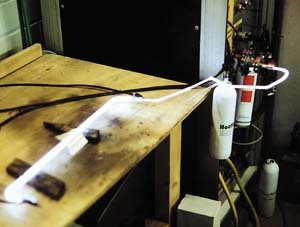


 Photo Gallery2 weeks ago
Photo Gallery2 weeks ago
 Paula Fargo2 weeks ago
Paula Fargo2 weeks ago
 Real Deal1 week ago
Real Deal1 week ago
 Photo Gallery2 weeks ago
Photo Gallery2 weeks ago
 Projects1 week ago
Projects1 week ago
 Women in Signs2 weeks ago
Women in Signs2 weeks ago
 Signs of the Times2 weeks ago
Signs of the Times2 weeks ago
 Business Management7 days ago
Business Management7 days ago